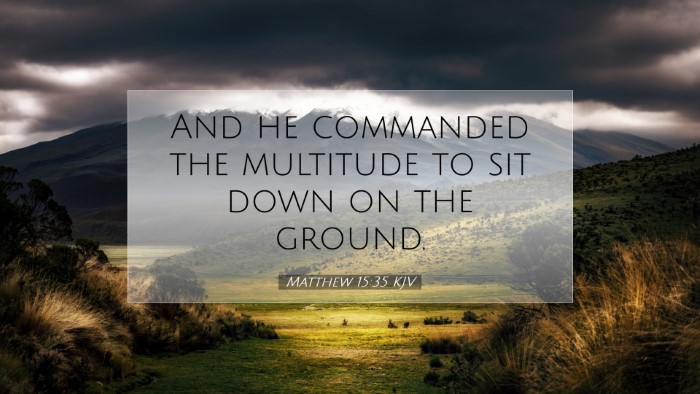Commentary on Matthew 15:35
Verse Context: This verse, found within the narrative of the feeding of the four thousand, illustrates a significant miracle performed by Jesus. His compassionate response to the needs of the crowd underscores the themes of provision and divine care.
General Overview
This passage presents a miraculous event where Jesus, having gathered a multitude, demonstrates His ability to meet both spiritual and physical needs. The emphasis on the multitude emphasizes not only the love and concern of Christ but also His divine authority to provide.
The Significance of the Number Four Thousand
Matthew Henry notes that while the feeding of the five thousand is more popular, this event is no less significant. The number four thousand highlights the inclusiveness of Christ's ministry, extending beyond the Jewish people to a broader audience. This fulfills the prophecy of gathering nations into His fold.
Understanding the Compassion of Jesus
The text portrays a deep compassion in Jesus. Albert Barnes focuses on this attribute, suggesting that Christ’s compassion is what drives Him to act. He refuses to send the crowds away hungry, illustrating that genuine care forms the basis of His miracles. Jesus’ desire to meet physical needs is reflective of His overall mission to seek and save the lost.
Preparation before the Miracle
According to Adam Clarke, the miracle did not happen spontaneously but followed a period of preparation. Jesus called His disciples to Him, indicating that preparation is crucial in ministry. This shows that before a great work of God, there may be a process of discussion and understanding among His followers, which is essential for a partnership in His ministry.
The Role of the Disciples
The involvement of the disciples is significant in this passage. Clarke emphasizes that they were first invited to recognize the need before they saw Jesus perform the miracle. This aspect suggests a lesson for pastors and leaders today: recognizing needs in the congregation and participating in God’s provision is vital for effective ministry.
Spiritual Application of the Miracle
This miracle symbolizes more than just physical sustenance. According to Henry, it points to the spiritual nourishment that Jesus provides. Just as the multitude was fed with bread, so are believers fed with the bread of life, which is Christ Himself. This highlights the duality of physical and spiritual needs, a critical understanding for anyone involved in pastoral care.
The Abundance of Provision
The leftovers collected after the meal reflect the abundance of Christ’s provision. Barnes emphasizes that God’s resources are not merely sufficient but abundant. This serves to remind readers that God can provide not only what is needed but more than enough to meet both physical and spiritual needs.
The Importance of Gratitude
Both Clarke and Henry recognize the importance of responding to God’s provision with gratitude. The act of giving thanks before distributing the food models an attitude of thankfulness essential in Christian life. Pastors and leaders should instill this attitude within their congregations, emphasizing that gratitude opens the door for further blessings.
Conclusion: Christ as Our Provider
Matthew 15:35 invites us to see Christ as the provider in all aspects of life. This commentary draws on public domain perspectives to enrich our understanding of the text. The lessons of compassion, preparation, involvement, spiritual nourishment, and gratitude serve as foundational principles for pastors, theologians, and students of the Word. As we reflect on this passage, may we be encouraged to apply these truths to our ministries and personal lives.


